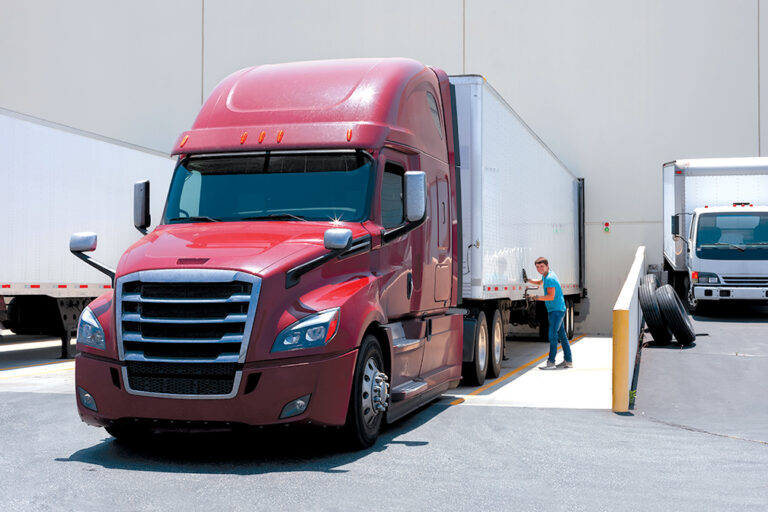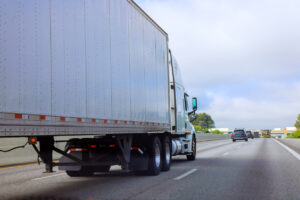Safety is important for every driver. Most learn early in their CDL careers how to stay safe on the road, and many receive periodic training from the carrier they drive for.
While training for safety when driving is widely available, there is another part of the job where safety training is often neglected: Dangers exist in, on and around the trailer while it is being loaded or unloaded.
If you pull a van or refrigerated trailer, the area directly behind the trailer is a common place for accident and injury. Flatbed and curtainside trailers are often surrounded by moving forklifts or other equipment and sometimes carry heavy items that can fall. Securing and tarping loads often requires climbing on and around freight that can shift or roll.
Tank trailers often require climbing on top, and present dangers of their own. Many tanker facilities are equipped with safety harnesses in case of a fall. Use them.
For a van trailer, it seems simple. Remove the seal and/or lock, lift the latch and swing it out, and get those doors open so you can back into the dock. Unfortunately, as too many drivers have learned the hard way, this simple operation isn’t always a safe one. Cargo that has shifted in transit can force the doors to open quickly, or the load can even fall on an unsuspecting driver.
Moreover, trailers that are assigned to trailer pools at customer locations may not receive regular maintenance attention as they are shuttled from one customer lot to another. Issues with door hardware such as hinges and latches may not have been reported by drivers who used the trailer previously.
There are techniques for opening the doors safely. Following them isn’t a guarantee that nothing will happen — but it does reduce the risk of getting hurt.
Before approaching the doors at all, an inspection is in order. Check the ground surface behind the trailer. There may be potholes or, in the case of gravel lots or yards, uneven surfaces. Even if the surface is smooth and level, look for loose sand or dirt that could impact traction. Caution is required on ice and snow, too.
Next, check the back of the trailer. Look at the hinges: Check for cracks or breaks. Also watch for doors that aren’t “square” to the trailer body. Doors are heavy, and a broken hinge can result in the door falling (or at least opening in an unexpected way).
Once you decide it’s safe to open the doors, make it a habit never to stand directly in the path of the one you are opening. While you open one door, stand behind the other, still-secured door. Then, as the door opens, check carefully for any boxes or containers leaning against the door being opened. They will likely fall as the door opens, so make sure you aren’t standing where they’ll land on you. If you’re standing behind the other, still latched door, you’ll have a barrier between you and the falling items.
Have a firm grip on the door, especially if it’s windy. Doors have a lot of surface area for the wind to catch and can open suddenly and violently if they get loose. Drivers have been killed after being struck in the head by doors that swung open quickly.
If freight does fall, think twice about trying to catch it. Instinctively, you may try to prevent damage, but items falling from higher up gain momentum on the way down. Even lightweight boxes can cause injury if the corner strikes first.
Once the door is open, secure it so it stays that way while you back into the dock. Most doors are equipped with a length of chain or a T-shaped bar that attaches to a provided hook, but these devices can come loose while backing because of uneven terrain, wind and other factors. This can damage the doors and other vehicles on either side, as well as pedestrians who might be close by. It’s a good idea to add a bungee cord to help keep the chain in place so the door stays secure. That little extra effort can help prevent an expensive incident.
With one door open, it’s easier to check for freight leaning against the other door and make adjustments if boxes are light enough to handle. If heavy objects such as large rolls of paper are leaning against the door, get help before trying to move the freight.
Drivers hauling trailers with roll-up doors aren’t immune to injury, either. Roll-up doors have more hinges and other mechanical parts — like cables, tracks and rollers — that can deteriorate over time, causing the door to close suddenly. It’s worth an inspection, before loading if possible. Check both sides of the door for missing nuts or bolts, broken hinges or any other part that looks suspicious.
For flatbed and other open-deck trailers, it pays to be vigilant while loading and unloading. Drivers have been injured by forklifts, cranes and other loading equipment. When straps or chains are removed, freight can shift suddenly, falling off the trailer onto an unsuspecting driver. This is especially true of rounded items, such as pipes or logs.
Injuries have also happened as drivers attempt to “help” a forklift operator by holding back curtains or tarps, or attempting to keep freight from moving while an equipment operator gets positioned. Never place yourself between the trailer and the unloading equipment. If you must assist, watch carefully for freight movement and be prepared to escape if something moves.
Every trailer type has its own pitfalls when it comes to loading and unloading. The best practice is for the driver to be someplace else, away from any danger. Unfortunately, that isn’t always possible.
The risk of injuries around the trailer may not seem as high as in a highway accident, but pain, disability and death are still possible. You can reduce your chances of getting hurt by being as safety-conscious around the trailer as you are in the cab of the tractor.
Cliff Abbott is an experienced commercial vehicle driver and owner-operator who still holds a CDL in his home state of Alabama. In nearly 40 years in trucking, he’s been an instructor and trainer and has managed safety and recruiting operations for several carriers. Having never lost his love of the road, Cliff has written a book and hundreds of songs and has been writing for The Trucker for more than a decade.















